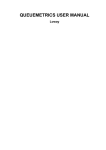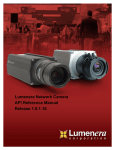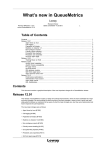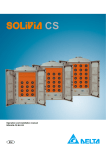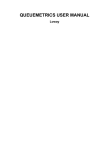Download Accessing QueueMetrics through its XML-RPC interface
Transcript
Accessing QueueMetrics
through its XML-RPC interface
Loway
Revision $Revision: 1.14 $ covers QueueMetrics 1.6.2.0
Revision History
$Date: 2010/10/04 10:33:06 $
L
Table of Contents
Document contents ............................................................................................................. 2
Revision history ......................................................................................................... 2
What is XML RPC? ........................................................................................................... 2
Which functions does QueueMetrics export as XML-RPC? ................................................ 3
Example: accessing QueueMetrics from Python ............................................................... 3
Example: Accessing QueueMetrics from Java .................................................................. 3
Example: Accessing QueueMetrics from PHP .................................................................. 4
Example: Accessing QueueMetrics from JavaScript .......................................................... 7
Understanding call parameters .............................................................................................. 9
The method QM.stats .................................................................................................. 9
The method QM.realtime ........................................................................................... 10
The method QM.qareport ........................................................................................... 10
The method QM.qaformreport ..................................................................................... 11
The method QM.qaformsummary ................................................................................ 11
The method QM.qaformgrading ................................................................................... 12
The method QM.auth ................................................................................................ 12
The method QM.findAudio ......................................................................................... 13
Understanding results ........................................................................................................ 13
Using an external auth source for QueueMetrics ..................................................................... 14
Log on procedure ..................................................................................................... 14
XML-RPC call parameters ......................................................................................... 15
A. Response block names ................................................................................................... 16
Response block names for QM.stats ............................................................................. 16
Response block names for QM.realtime ........................................................................ 17
DataObject: RealtimeDO .................................................................................... 17
Response block names for QM.qareport ........................................................................ 17
DataObject: QualAssDO .................................................................................... 17
Response block names for QM.qaformreport and QM.qaformgrading ................................. 18
DataObject: QualAssFormDO ............................................................................. 18
Response block names for QM.qaformsummary ............................................................. 18
DataObject: QualAssDO .................................................................................... 18
Response block names for QM.auth ............................................................................. 18
Response block names for QM.findAudio ..................................................................... 19
Appendix II: A short list of XML-RPC libraries ..................................................................... 19
Document contents
2
Document contents
This document details how to access and use the XML-RPC access functionality in Loway QueueMetrics. This makes it possible for your programs to leverage the power of QueueMetrics by calling a very
simple API, with bindings available in nearly every programming language.
Revision history
• Nov 13, 2006: First draft
• March 22, 2007: Added PHP example
• April 13, 2007: "raw" blocks available
• May 11, 2007: real-time blocks and auth server
• Jun 11, 2007: multi-stint calls
• Nov 11, 2007: enter-queue position and schedule adherence
• Nov 10, 2008: Added Outcomes data blocks and external XML-RPC Authentication description
• Jan 14, 2009: Added support for JavaScript
• Feb 11, 2009: Moved to AsciiDoc format for ease of updating
• Feb 17, 2009: Added QM.findAudio methods
• Aug 07, 2009: Added QM.qareport and QM.qaformreport reports
• Aug 10, 2009: Added AgentsDO.AnsCallsCG for "Answered calls by custom group" reporting
• Dec 2, 2009: Added QM.qaformsummary report
• Jul 8, 2010: Added new blocks "Call Overview", "Traffic analysis", "Agent performance"
• Jul 21, 2010: Added QM.qaformgrading method
• Aug 20, 2010: Added new block "Inclusive Answered SLA"
• Oct 1, 2010: Referenced QM manual for possible data blocks.
What is XML RPC?
Wikipedia defines XML-RPC as:
XML-RPC is a remote procedure call protocol which uses XML to encode its calls and HTTP as a transport mechanism. It is a very simple protocol, defining only a handful of data types and commands, and
the entire description can be printed on two pages of paper. This is in stark contrast to most RPC systems, where the standards documents often run into the thousands of pages and require considerable
software support in order to be used.
This means that, whatever your programming language of choice, you can surely find an XML-RPC library for it; and once you have the library, connection to QueueMetrics with it is straightforward.
Which functions does QueueMetrics export as XMLRPC?
3
Which functions does QueueMetrics export as XMLRPC?
QueueMetrics exports the full results of an analysis in XML-RPC, so you can access whatever information you feel you may need. Information is divided into blocks, i.e. sets of data that correspond roughly
to the tables QM uses for its own output.
This means that you can build software that sits on top of QueueMetrics and uses its result as a starting
point for further elaboration, e.g.:
• Visualizing results with complex graphs currently not supported by QueueMetrics
• Computing period comparison analyses (one period versus another period)
• Accessing agent presence data for payroll computation
Of course there are a very big number of possible scenarios where you might want to use such information.
The XML-RPC interface is available in all version of QueueMetrics starting from version 1.3.1.
Example: accessing QueueMetrics from Python
In this example we’ll see how easy it is to access QueueMetrics from a scripted language like Python.
You can enter the following statements interactively using a Python IDE like IDLE, or make them a part
of a larger program.
The following code connects to a the XML-RPC port of a QueueMetrics instance running at http://qmserver:8080/qm130 and asks for a couple of tables, namely the distribution of answered calls per day
and the Disconnection causes.
>
>
>
>
import xmlrpclib
server_url = ’http://qmserver:8080/qm130/xmlrpc.do’;
server = xmlrpclib.Server(server_url);
res = server.QM.stats( "queue-dps", "robot", "robot","", "", "2005-10-10.10:23:12
> res.keys()
[’CallDistrDO.AnsDistrPerDay’, ’result’, ’KoDO.DiscCauses’]
> res[’result’]
[[’Status’, ’OK’], [’Description’, ’’], [’Time elapsed (ms)’, 3008], [’QM Version’,
> res[’result’][2][1]
3008
As you can see, it only takes four lines of Python code to connect to QueueMetrics and get all the results
back!
Example: Accessing QueueMetrics from Java
This is an example functionally equivalent to the one above in Python, but it’s written in Java using the
Redstone XML-RPC client library.
import java.io.IOException;
import java.util.HashMap;
import java.net.URL;
Example: Accessing QueueMetrics from PHP
import redstone.xmlrpc.XmlRpcClient;
import java.util.ArrayList;
public class xmlRpcTestClient {
public void perform() {
String stUrl = "http://server:8080/qm130/xmlrpc.do";
System.setProperty(
"org.xml.sax.driver",
"org.apache.xerces.parsers.SAXParser"
);
try {
XmlRpcClient client = new XmlRpcClient( stUrl, false );
ArrayList arRes = new ArrayList();
arRes.add( "OkDO.AgentsOnQueue" );
arres.add( "KoDO.DiscCauses" );
arRes.add( "KoDO.UnansByQueue" );
arRes.add( "DetailsDO.CallsKO" );
Object[] parms = { "queue-dps", "robot", "robot",
"", "", "2005-10-10.10:23:12",
"2007-10-10.10:23:10",
"", arRes };
Object token = client.invoke( "QM.stats", parms );
HashMap resp = (HashMap) token;
System.out.println( "Resp: " + resp );
} catch ( Exception e ) {
e.printStackTrace();
}
}
public static void main(String[] args) {
xmlRpcTestClient c = new xmlRpcTestClient();
try {
c.perform();
} catch (Exception e ) {
e.printStackTrace();
}
}
}
We’ll have to explicitly set which XML parser to use; for the rest, the code looks very much alike the
Python one.
Example: Accessing QueueMetrics from PHP
This example is based on PHP’s XML_RPC class, that is a part of PEAR and so should be preinstalled
with any modern PHP installation.
<h1>A QueueMetrics XML-RPC client in PHP</h1>
<?
require_once ’XML/RPC.php’;
4
Example: Accessing QueueMetrics from PHP
5
$qm_server = "10.10.3.5"; // the QueueMetrics server address
$qm_port
= "8080";
// the port QueueMetrics is running on
$qm_webapp = "queuemetrics-1.3.3"; // the webapp name for QueueMetrics
// set which response blocks we are looking for
$req_blocks = new XML_RPC_Value(array(
new XML_RPC_Value("DetailsDO.CallsOK"),
new XML_RPC_Value("DetailsDO.CallsKO")
), "array");
// general invocation parameters - see the documentation
$params = array(
new XML_RPC_Value("queue-dps"),
new XML_RPC_Value("robot"),
new XML_RPC_Value("robot"),
new XML_RPC_Value(""),
new XML_RPC_Value(""),
new XML_RPC_Value("2007-01-01.10:23:12"),
new XML_RPC_Value("2007-10-10.10:23:10"),
new XML_RPC_Value(""),
$req_blocks
);
$msg = new XML_RPC_Message(’QM.stats’, $params);
$cli = new XML_RPC_Client("/$qm_webapp/xmlrpc.do", $qm_server, $qm_port);
//$cli->setDebug(1);
$resp = $cli->send($msg);
if (!$resp) {
echo ’Communication error: ’ . $cli->errstr;
exit;
}
if ($resp->faultCode()) {
echo ’Fault Code: ’ . $resp->faultCode() . "\n";
echo ’Fault Reason: ’ . $resp->faultString() . "\n";
} else {
$val = $resp->value();
$blocks = XML_RPC_decode($val);
// now we print out the details....
printBlock( "result", $blocks );
printBlock( "DetailsDO.CallsOK", $blocks );
printBlock( "DetailsDO.CallsKO", $blocks );
}
// output a response block as HTML
function printBlock( $blockname, $blocks ) {
echo "<h2>Response block: $blockname </h2>";
echo "<table border=1>";
$block = $blocks[$blockname];
for ( $r = 0; $r < sizeof( $block ); $r++ ) {
echo "<tr>";
for ( $c = 0; $c < sizeof( $block[$r] ); $c++ ) {
Example: Accessing QueueMetrics from PHP
6
echo( "<td>" . $block[$r][$c] . "</td>" );
}
echo "</tr>\n";
}
echo "</table>";
}
?>
In this next example, the PHP code is able to submit QA grading information in order to fill a specific
form:
<?php
require_once ’XML/RPC.php’;
$qm_server = "10.10.3.5"; // the QueueMetrics server address
$qm_port
= "8080";
// the port QueueMetrics is running on
$qm_webapp = "queuemetrics-1.3.3"; // the webapp name for QueueMetrics
// set which response blocks we are looking for
$req_blocks = new XML_RPC_Value(array(
new XML_RPC_Value("QualAssFormDO.FormStructure"),
new XML_RPC_Value("QualAssFormDO.SectionValues"),
new XML_RPC_Value("QualAssFormDO.Comments"),
), "array");
// set notes we want to update
$comments_block = new XML_RPC_Value(array(
new XML_RPC_Value("This is a form note added with XMLRPC"),
new XML_RPC_Value("This is the next form note added with XMLRPC"),
), "array");
// set QA infor scores to be
// Each item code should be defined.
// Each item will be associated to a score number
// or an empty string if N/A (only for Not Mandatory fields)
$grading_info = new XML_RPC_Value(array(
’NMYN’ => new XML_RPC_Value("", ’string’),
’NMNUM’ => new XML_RPC_Value("20", ’string’),
’MNUM’ => new XML_RPC_Value("60", ’string’),
’MMUL’ => new XML_RPC_Value("100", ’string’),
), "struct");
// general invocation parameters - see the documentation
$params = array(
new XML_RPC_Value(""),
new XML_RPC_Value("robot"),
new XML_RPC_Value("robot"),
new XML_RPC_Value("2010-06-16.12:32:00"),
new XML_RPC_Value("3600"),
new XML_RPC_Value("Test GUI items"),
new XML_RPC_Value("1276684326.309"),
$grading_info,
$comments_block,
$req_blocks
Example: Accessing QueueMetrics from JavaScript
7
);
$msg = new XML_RPC_Message(’QM.qaformgrading’, $params);
$cli = new XML_RPC_Client("/$qm_webapp/xmlrpc.do", $qm_server, $qm_port);
//$cli->setDebug(1);
$resp = $cli->send($msg);
if (!$resp) {
echo ’Communication error: ’ . $cli->errstr;
exit;
}
if ($resp->faultCode()) {
echo ’Fault Code: ’ . $resp->faultCode() . "\n";
echo ’Fault Reason: ’ . $resp->faultString() . "\n";
} else {
$val = $resp->value();
$blocks = XML_RPC_decode($val);
// now we print out the details....
printBlock( "result", $blocks );
printBlock( "QualAssFormDO.FormStructure", $blocks );
printBlock( "QualAssFormDO.SectionValues", $blocks );
printBlock( "QualAssFormDO.Comments", $blocks );
}
// output a response block as HTML
function printBlock( $blockname, $blocks ) {
echo "\nResponse block: $blockname \n";
$block = $blocks[$blockname];
for ( $r = 0; $r < sizeof( $block ); $r++ ) {
echo "\n";
for ( $c = 0; $c < sizeof( $block[$r] ); $c++ ) {
echo( $block[$r][$c] . "\t" );
}
}
}
?>
As you can see, it is very similar to the other programming languages, and reading into the results is
simply a matter of selecting the correct block and then accessing the data cell by row and column. The
added complexity is due to the explicit error condition check and result printout.
Example: Accessing QueueMetrics from JavaScript
In order to access the XML-RPC interface from JavaScript, you need to use an adaptor library. We
have been able to use successfully a library called JSON-XML-RPC that can be found at http://
code.google.com/p/json-xml-rpc/ in a file caller rpc.js
Generally speaking, a JavaScript client can make requests only against the same server that is serving
the HTML page, therefore you need to install it on the same server as QueueMetrics, creating a separate
webapp.
Example: Accessing QueueMetrics from JavaScript
<html>
<head>
<title>javascript_client.html</title>
<script src="rpc.js"></script>
</head>
<body>
<h1>QueueMetrics JavaScript XML-RPC example </h1>
<script>
var server = "/DAILY/xmlrpc.do";
function run() {
try {
var service = new rpc.ServiceProxy( server, {
asynchronous:false,
protocol: "XML-RPC",
methods: ["QM.stats", "QM.realtime", "QM.auth"]
} );
res = service.QM.stats( "q1", "robot", "robot","", "",
"2005-10-10.10:23:12", "2009-10-10.10:23:10","",
[ "KoDO.DiscCauses", "CallDistrDO.AnsDistrPerDay" ]
);
document.getElementById("RESULT").innerHTML = plotBlocks(res);
} catch(e) {
alert("Error raised: " + e);
}
}
function plotBlocks( hmBlocks ) {
s = "";
for (var i in hmBlocks) {
s += "<h2>Block: " + i + "</h2>";
s += plotBlock( hmBlocks[i] );
}
return s;
}
function plotBlock( arBlock ) {
s = "";
for ( r =0; r < arBlock.length; r++ ) {
s += "<tr>";
for ( c = 0; c < arBlock[r].length; c++ ) {
s += "<td>" + arBlock[r][c] + "</td>";
}
s += "</tr>";
}
return "<table border=1>" + s + "</table>";
}
</script>
<input type="button" value="Click me!" onclick="run();" >
<div id="RESULT"></div>
</body>
8
Understanding call parameters
9
</html>
As you can see, the code is actually very similar to the Python one. The only important difference here is
that the names of the methods have to be explicitly declared.
Understanding call parameters
There are three methods exported by the XML-RPC interface, and they are used for three different reasons:
• QM.stats: get the main historical stats
• QM.realtime: get the real time stats (available since QM 1.3.5)
• QM.qareport: get the Quality Assessment statistics (available since QM 1.6.0)
• QM.qaformreport: get some Quality Assessment Forms details (available since QM 1.6.0)
• QM.qaformsummary: get Quality Assessment statistics related to same form (available since QM
1.6.0)
• QM.qaformgrading: fill a QA form with the specified scores and/or comments (available since QM
2.0.0 \todo)
• QM.auth: use QueueMetrics as an auth server for third party software (available since QM 1.3.5)
The method QM.stats
This is the main methods exported, its XML-RPC name being QM.stats. It takes a number of arguments,
all of which must be supplied and all of which must have the correct data type. They are:
1. (String) Queue name or names: the set of queues that must be include in the analysis. They must be
separated by a "|" symbol if more than one queue is passed. The queue name is the internal Asterisk
queue name.
2. (String) Access username: this one must be the user name of an active user holding the key ROBOT.
3. (String) Access password: this one must be the clear-text password of the given user name
4. (String) Logfile - always leave blank.
5. (String) Period - always leave blank.
6. (String) Start of period. This must be written in exactly the format yyyy-mm-dd.hh.mm.ss (do not
forget the dot between the date and the hour).
7. (String) End of period. Same format as start of period
8. (String) Agent filter - an agent’s name, like "Agent/101" that must be the filter for all the relevant activity
9. (List) A list of the required analyses to be returned to the client. Each analysis name must be supplied
as a String.
This call will start up a session in QueueMetrics, check if the user exists and has the privilege to run the
report, run the analysis, prepare the required results and return them. At the end of the call, the QueueMetrics session is destroyed so no data is kept for further elaboration.
The method QM.realtime
10
This means that it’s usually the most efficient thing to do to request all needed response information and
once, but it’s wise to limit yourself to the minimum data set you will actually need, as each block takes
up CPU and memory space to be marshaled between the native Java format, the intermediate XML format and the resulting client format.
It is also advisable to run large data set analysis at night time or when nobody is accessing the system,
as they may take quite a lot of RAM and CPU, and this may slow down QueueMetrics for the other live
users.
The method QM.realtime
This method is very similar to QM.stats but it is used to retrieve the real time stats. It must be called
with the following parameters:
1. (String) Queue name or names: the set of queues that must be included in the analysis. They must be
separated by a "|" symbol if more than one queue is passed. The queue name is the internal Asterisk
queue name.
2. (String) Access username: this one must be the user name of an active user holding the key ROBOT.
3. (String) Access password: this one must be the clear-text password of the given user name
4. (String) Logfile - always leave blank.
5. (String) Agent filter - an agent’s name, like "Agent/101" that must be the filter for all the relevant activity
6. (List) A list of the required analyses to be returned to the client. Each analysis name must be supplied
as a String.
The same suggestions that are given for QM.stats apply.
Important
Please note that there is a difference between results produced by the XML rpc realtime
calls and the realtime statistics produced through the QueueMetrics GUI when the key
realtime.members_only is equal to true. The difference is related to the agents list shown. Being the list of queues, in the XML RPC call, specified by a list of names instead of a list of
queue unique identifiers, is not possible to correctly identify elementary queues from macro
queues having the same name. In this situation the agent list will always be calculated as sum
of all agents associated to all elementary queues composing the macro queue, even if the macro
queue has directly assigned agents.
The method QM.qareport
This method is very similar to QM.stats but it’s used to retrieve Quality Assessment statistics. It must be
called with the following parameters:
1. (String) Queue name or names: the set of queues that must be included in the analysis. They must be
separated by a "|" symbol if more than one queue is passed. The queue name is the internal Asterisk
queue name.
2. (String) Access username: this one must be the user name of an active user holding the key ROBOT.
3. (String) Access password: this one must be the clear-text password of the given user name
The method QM.qaformreport
11
4. (String) Start of period. This must be written in exactly the format yyyy-mm-dd.hh.mm.ss (do not
forget the dot between the date and the hour).
5. (String) End of period. Same format as start of period
6. (String) Agent filter - an agent’s name, like "Agent/101" that must be the filter for all the relevant activity
7. (String) The form name for wich you need to have information
8. (List) A list of the required analyses to be returned to the client. Each analysis name must be supplied
as a String.
The same suggestions that are given for QM.stats apply.
The method QM.qaformreport
This method is very similar to QM.stats but it’s used to retrieve raw information about Quality Assessment Forms. It must be called with the following parameters:
1. (String) Queue name or names: the set of queues that must be included in the analysis. They must be
separated by a "|" symbol if more than one queue is passed. The queue name is the internal Asterisk
queue name.
2. (String) Access username: this one must be the user name of an active user holding the key ROBOT.
3. (String) Access password: this one must be the clear-text password of the given user name
4. (String) Start of period. This must be written in exactly the format yyyy-mm-dd.hh.mm.ss (do not
forget the dot between the date and the hour).
5. (String) End of period. Same format as start of period
6. (String) Agent filter - an agent’s name, like "Agent/101" that must be the filter for all the relevant activity
7. (String) The form name for wich you need to have information
8. (List) A list of the required analyses to be returned to the client. Each analysis name must be supplied
as a String.
The same suggestions that are given for QM.stats apply.
The method QM.qaformsummary
This method is very similar to QM.stats but it’s used to retrieve aggregated information about a specific
Quality Assessment Forms. It must be called with the following parameters:
1. (String) Queue name or names: the set of queues that must be included in the analysis. They must be
separated by a "|" symbol if more than one queue is passed. The queue name is the internal Asterisk
queue name.
2. (String) Access username: this one must be the user name of an active user holding the key ROBOT.
3. (String) Access password: this one must be the clear-text password of the given user name
4. (String) Start of period. This must be written in exactly the format yyyy-mm-dd.hh.mm.ss (do not
forget the dot between the date and the hour).
The method QM.qaformgrading
12
5. (String) End of period. Same format as start of period
6. (String) Agent filter - an agent’s name, like "Agent/101" that must be the filter for all the relevant activity
7. (String) The form name for wich you need to have information
8. (List) A list of the required analyses to be returned to the client. Each analysis name must be supplied
as a String.
The same suggestions that are given for QM.stats apply.
The method QM.qaformgrading
This method lets you able to fill a QA form through an RPC-XML call. It replies with the same raw information reported by the QM.qaformreport method and could replace it if QA parameters are empty
when calling.
1. (String) Queue name or names: the set of queues that must be included in the analysis. They must be
separated by a "|" symbol if more than one queue is passed. The queue name is the internal Asterisk
queue name.
2. (String) Access username: this one must be the user name of an active user holding the key ROBOT.
3. (String) Access password: this one must be the clear-text password of the given user name
4. (String) Start of period. This must be written in exactly the format yyyy-mm-dd.hh.mm.ss (do not
forget the dot between the date and the hour).
5. (String) End of period. This is at least the number of seconds the call was in the waiting status (or the
complete call time or a suitable number that comfortably contains the call like, for example, 3600).
6. (String) The form name for wich you need to have information
7. (String) The unique identifier for the call to be graded
8. (Struct) The list of QA items score supplied as (string,string) pairs. The list should contain all specific
form items codes and their relative score. In order to specify N/A values for not mandatory items, an
empty string should be specified. If the list is left empty, no QA score will be filled into the form
9. (List) A list of the notes to be filled in the form. Each note must be supplied as a String. If the list will
be empty, no new comments will be added to the form.
10.(List) A list of the required analyses to be returned to the client. Each analysis name must be supplied
as a String.
The same suggestions that are given for QM.stats apply.
The method QM.auth
This method is used to authenticate a username / password couple against the QueueMetrics server. This
can be used by third-party software that does not want to keep its own separate user database but wants
to use QueueMetrics’ instead.
Call parameters:
1. (String) User name
The method QM.findAudio
13
2. (String) Password
Response
There is only one response block returned, named "auth", where the caller will retrieve all user data, including the live key set for that user.
The method QM.findAudio
This method is used to retrieve a recorded file name from the QueueMetrics server. In order to retrieve
the file name QM will invoke the currently configured Pluggable Modules to search within the current
recording set. This can be used by third-party software that needs to retrieve audio recordings via HTTP.
Call parameters:
1. (String) User name (*)
2. (String) Password (*)
3. (String) Server
4. (String) Asterisk-ID (*)
5. (String) Call start (integer timestamp)
6. (String) Agent
7. (String) Queue
The username and password of an user with ROBOT access are mandatory.
If QM is on a clustered setup, the Server parameter must be passed to qualify the Asterisk call-id.
The Asterisk-Id is mandatory and is the one retrieved in the Call Details blocks.
Some PM may optionally require the Call start, Agent and Queue parameters; those are used for fuzzy
matching of calls, e.g on an external storage. Most PMs that do an exact match do not need those parameters.
Response
There is only one response block returned, named "AudioFiles", where the caller will retrieve the filename of each recorded file and an URL to actually download the file.
The response may include zero or more files; it is well possible that multiple recordings be present for
one call.
A sample PHP file that shows how to access the findAudio interface is supplied with QueueMetrics.
Understanding results
The result of the analyses is made up of a Struct, i.e. an associative array similar to Java’s HashMap or
Perl’s Hash, that maps block names to blocks.
Each block is a rectangular data container made up of an Array of Arrays of Strings. The outer Array
contains the rows while the inner ones will hold column values.
Using an external auth source for QueueMetrics
14
In the response, you get all the requested blocks as of parameter #9 of the call, plus a block named response. The block response will contain:
• The status of the call: this should always be OK if no error was encountered. If this is not OK, the other blocks may be missing or be meaningless.
• The version of QueueMetrics running in the server
• The time elapsed to run the report.
All other blocks will follow the convention that the inner Array #0 (the first row) will contain table
headers, while actual data will be present from row 1 onwards. The table headers are the same you can
see in the on-screen representation.
The following Python code will run a simple dump of all the results in a readable form:
for t in res.keys():
print "===== Block " + t + ": ========"
for r in range( len(res[t]) ):
for c in range( len( res[t][r] )):
print res[t][r][c] ,
print "\t" ,
print
The output will look like the following one:
===== Block result:
Status
Description
Time elapsed (ms)
QM Version
========
OK
3008
1.3.1
===== Block KoDO.DiscCauses: ========
Cause
N. Calls
Caller abandon
46
83.6%
Agent dump
1
1.8%
Timeout (voicemail) 8
14.5%
...
As you can see, the block KoDO.DiscCauses has one full line of header on its first row.
Using an external auth source for QueueMetrics
It is possible for QueueMetrics to accept an external authentication source. By using a simple XMLRPC interface, it is be possible to write easily third party scripts that are able to authenticate against a
chosen authentication system (e.g. Kerberos, LDAP, a Microsoft domain server, etc).
Log on procedure
When an user logs in to QueueMetrics, QM checks to see if there is an XML-RPC auth source defined .
QueueMetrics will execute a query to that third-party server passing along the user-id and the password
given for authentication, plus a given service-id that will be defined in the configuration file.
The server will respond passing along a fixed set of data:
XML-RPC call parameters
15
• An auth response (see below)
• A set of login information for that user (e.g. real name, email)
• The current class and user keys for that user
If the class passed along is empty, only the user keys will be computed. If the class is not empty, it will
be searched by name on the QueueMetrics storage and it will be loaded. Trying to load a non-existent
class will result in auth failure.
The auth server may return four different responses:
• Access allowed
• Access allowed with supplied user data
• Access is forbidden
• Access is fully delegated to QM
The following table explains the relationship between those states:
Auth OK
Auth KO
User data from
RPC
AUTHORITA- FORBIDDEN
TIVE
User data from
QM
SUCCESSFUL DELEGATED
If auth was SUCCESSFUL, the local QM database is checked for that user name. If such a user is
present, the user details, class and key information are loaded from QM. If such a user is not present, the
details are taken from the ones supplied via XML-RPC.
If auth was AUTHORITATIVE, the details are taken from the ones supplied via XML-RPC. Then they
are copied to the local user database (with a random password) so that though the user cannot login manually, it is possible to decode the user name for all logged operations (e.g. Updating a queue). If a user
with the same name is present, its credentials are forcibly updated with the authoritative credentials.
If auth was FORBIDDEN, no other check is done and the user is rejected access.
If auth was DELEGATED, the standard QM logon procedure is done.
The whole procedure is wholly transparent to the user, that is they do not need to know which is the authority that grants or denies access.
XML-RPC call parameters
Method: QMAuth.auth
Table 1. Input parameters
Pos
Name
Type
Comment
0
System ID
String
As set in QM; if not set: blank
1
Username
String
2
Password
String
Response block names
16
Table 2. Output block
Pos
Name
Type
Comment
0
Status code
String
One of: * A (authoritative) * S (success) * F
(forbidden) * D (delegate) If other, behaves as
D.
1
Real name
String
2
Email
String
3
Class name
String
4
User keys
String
Must match an existing class
The following values are implied in QM:
• Enabled = yes
• Masterkey = no
The actual user data is only read by QM in case "A"; otherwise is ignored whatever is passed.
Tip: As a reference implementation, see the server that ships with QueueMetrics in the mysql-utils/xmlrpc/xmlrpc_auth_server.php file. It also contains an example of querying a LDAP server in PHP.
Configuration properties
A set of two new configuration properties control external auth sources in in QM:
Property
Description
default.authRpcServerUrl
If set, XML-RPC auth is used. Points to the URL of the auth server.
default.authSystemIdThe system-ID for this QM license. Can be currently any user-chosen name for the
system.
A. Response block names
Each XML-RPC call will have its own admissible set of block names that can be asked for. Response
blocks come in families, also known as Data Objects. Each response block name is made up of the Data
Object name dot the method name, as in KoDO.DiscCauses. Remember that response block names are
case sensitive.
Response block names for QM.stats
A complete list of possible QueueMetrics blocks is now maintained in the QueueMetrics User Manual,
chapter 6 "Report Details". The User Manual can be obtained from the QueueMetrics website.
For every possible block there is a name, a description, a "shortcut code" for ease of identification and
an XML-RPC code. That is the name of the block that it to be retrieved over XML-RPC.
Note
For example, if we want to access the "Disconnection Causes" block, we will look it up in the
manual until we encounter "UN03 - Disconnection Causes".
Response block names for QM.realtime
We see that its XML-RPC code is "KoDO.DiscCauses", so that is the name of the block we’ll
be asking for. Block names are case-sensitive, so make sure you are writing it as it is on the User Manual.
Response block names for QM.realtime
DataObject: RealtimeDO
Real-time information, as displayed in the main QM real-time page, using system defaults.
Method
Description
RTRiassunto
An overview table of the queues in use.
RTCallsBeingProc Calls being processed in real-time
RTAgentsLoggedIn
Agents logged in and paused
Response block names for QM.qareport
DataObject: QualAssDO
Quality Assessment information, as displayed in the QA report page.
Method
Description
TrkCalls
Tracked calls per agent report
TrkCallsQ
Tracked calls per queue report
CallSupervs
Supervisors tracking calls report
Res1
Section 1 (as defined in the form) calls by agent report
Res1Q
Section 1 (as defined in the form) calls by queue report
Res2
Section 2 (as defined in the form) calls by agent report
Res2Q
Section 2 (as defined in the form) calls by queue report
Res3
Section 3 (as defined in the form) calls by agent report
Res3Q
Section 3 (as defined in the form) calls by queue report
Res4
Section 4 (as defined in the form) calls by agent report
Res4Q
Section 4 (as defined in the form) calls by queue report
Res5
Section 5 (as defined in the form) calls by agent report
Res5Q
Section 5 (as defined in the form) calls by queue report
Res6
Section 6 (as defined in the form) calls by agent report
Res6Q
Section 6 (as defined in the form) calls by queue report
Res7
Section 7 (as defined in the form) calls by agent report
Res7Q
Section 7 (as defined in the form) calls by queue report
Res8
Section 8 (as defined in the form) calls by agent report
Res8Q
Section 8 (as defined in the form) calls by queue report
Res9
Section 9 (as defined in the form) calls by agent report
17
Response block names for QM.qaformreport and
QM.qaformgrading
Method
Description
Res9Q
Section 9 (as defined in the form) calls by queue report
Res10
Section 10 (as defined in the form) calls by agent report
Res10Q
Section 10 (as defined in the form) calls by queue report
AgentDetail
Tracked calls details for each defined agent
18
Response block names for QM.qaformreport and
QM.qaformgrading
DataObject: QualAssFormDO
Quality Assessment information related to QA Forms.
Method
Description
FormStructure
The data structure of specified form
SectionValues
Raw QA values for each section in forms matching the query
Comments
Comments associated to forms matching the query
Response block names for QM.qaformsummary
DataObject: QualAssDO
Quality Assessment information related to QA Forms.
Method
Description
FormSummary
Aggregated information for the specified form
Response block names for QM.auth
The QM.auth call will return one single block named "auth".
This block contains the following information:
• UserName: the login name
• Status: OK if authentication was passed or ERR if it was not passed
• FullName: The user’s full name
• Email: The user’s email address
• Class: The name of the class the user belongs to
• Keys: The active key set of the user, that is, all keys given to the class plus or minus the keys that
have been granted or revoked to this specifical user
• Masterkey: If set to 1, this user has a Masterkey, that is this user will pass each key ckeck
• NLogons: The number of logons the user has made. Each successful QM.auth call counts as a logon.
Response block names for QM.findAudio
19
Response block names for QM.findAudio
The QM.findAudio call will return one single block named "AudioFiles".
This block contains the following information:
• Column 0: Filename. A file name of the audio file
• Column 1: URL. The download URL for this audio recording.
If no calls are found, the block has zero rows.
Appendix II: A short list of XML-RPC libraries
To access QueueMetrics, you only need a library with Client capabilities. Server capabilities are not
needed. The following list is by no means exhaustive of all possible implementations available:
Perl
The BlackPerl library is available at http://www.blackperl.com/RPC::XML/
Python
The xmlrpclib ships with any modern version of the language.
JavaScript
The JSON-XML-RPC library can be found at: http://code.google.com/p/jsonxml-rpc/
JavaScript (2)
The Jsolait library also offers an XML-RPC module: http://jsolait.net/
Java
There are a lot of implementations available for Java, we recommend
Redstone’s LGPL library - http://xmlrpc.sourceforge.net/
C / C++
See http://xmlrpc-c.sourceforge.net/
C# / .Net
A connector is available at http://www.xml-rpc.net/
VisualBasic
A COM component that will work on most languages on the Windows platform: http://sourceforge.net/projects/comxmlrpc
PHP
The package XML_RPC is a part of the standard Pear library.





















